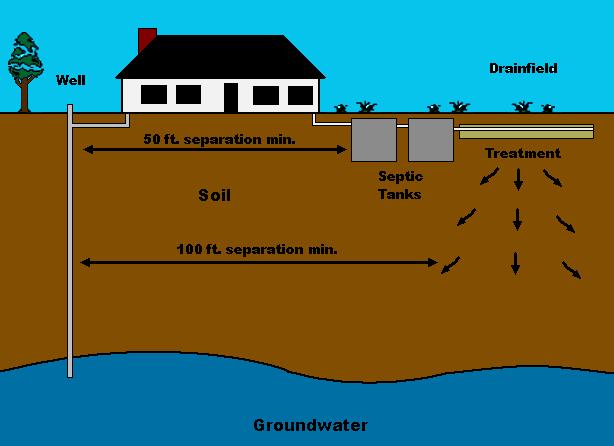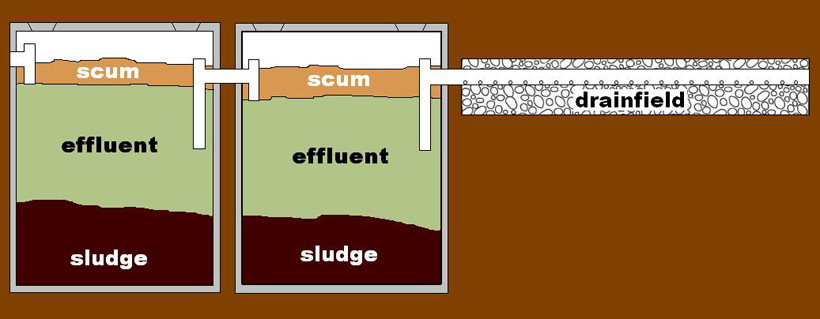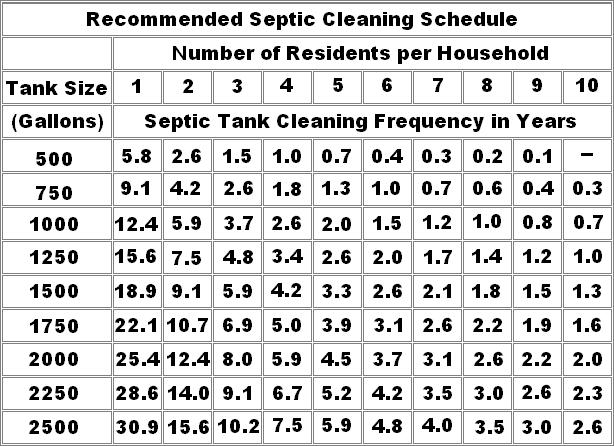CONVENTIONAL SEPTIC SYSTEM
The Tank:
The typical septic tank is a large buried cylindrical container made of concrete. A septic tank's purpose is to separate solids from the wastewater, store and partially decompose as much solid material as possible, while allowing the liquid (or effluent) to go to the drainfield.
Wastewater from your toilet, bath, kitchen, and laundry flows into the tank and remains there for up to 24 hours (known as the retention time) before it passes to the drainfield. This helps prevent clogging of the drainfield, which can lead to failure and costly repairs. Retention time is necessary to allow the solids to properly separate from the liquids—heavy solids settle to the bottom as sludge and the lighter particles rise to the top, forming a scum layer. Although bacterial action partially decomposes some of the solids, up to 50 percent remain in the tank.
As wastewater flows into the tank, a tee (or baffle) at the tank's inlet pipe slows the incoming wastes and reduces the disturbance of the settled sludge. The outlet tee keeps the solids or scum in the tank.
As the volume of sludge and scum builds up, there is less space and time for the solids to separate before the wastewater leaves the tank, which causes the system to be less effective. With not enough time for solids to settle, they can pass into the drainfield with the wastewater. This causes the drainfield to gradually plug and eventually fail, causing sewage to back up into the house or effluent to surface outside. Also, the closer the thickening scum and sludge layers come to the outlet tees, the greater the risk that they can plug the tank inlet or pass into the drainfield. The most common reason for system failure is not having the solids removed on a regular basis.
Consequently, it is important that solids be removed by periodic pumping, so they do not overflow into the drainfield. Most septic tanks need to be pumped every 2 to 3 years, depending on the tank size and the amount and type of solids entering the tank. (see chart below)
The Drainfield:
After solids settle in the septic tank, the liquid wastewater (or effluent) is discharged to the drainfield, also known as an absorption or leach field. The final treatment takes place in the soil below the drainfield.
The drainfield has a network of perforated pipes laid in gravel-filled trenches (2-3 feet wide) or beds (over 3 feet wide) in the soil. Wastewater trickles out of the pipes, through the gravel layer, and into the soil. The size and type of drainfield depends on the estimated daily wastewater flow and soil conditions.

The Soil:
The soil below the drainfield provides the final treatment and disposal of the septic tank effluent. After the wastewater has passed into the soil, chemical and biological processes treat the effluent before it percolates downward and outward, eventually entering the groundwater. These processes work best where the soil is somewhat dry, permeable, and contains plenty of oxygen for several feet below the drainfield.



